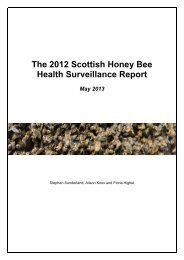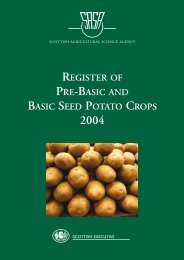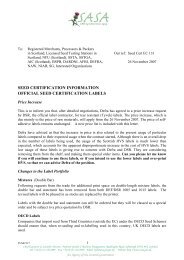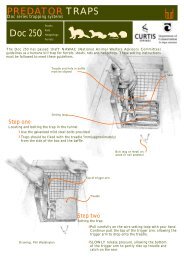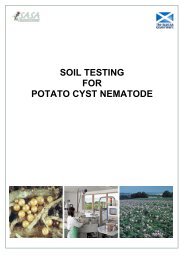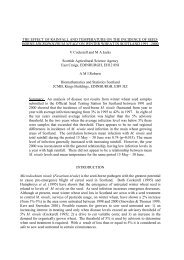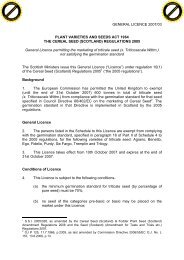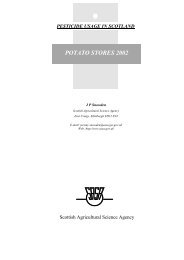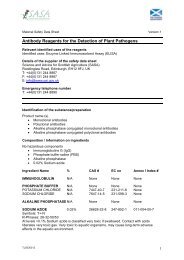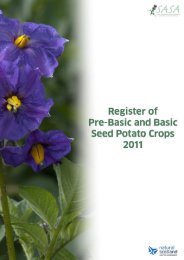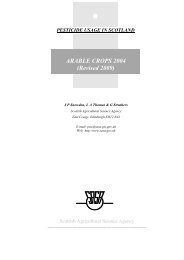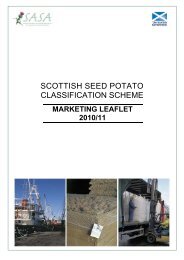You also want an ePaper? Increase the reach of your titles
YUMPU automatically turns print PDFs into web optimized ePapers that Google loves.
<strong>Crop</strong> <strong>Production</strong> <strong>in</strong> <strong>the</strong> <strong>East</strong> <strong>of</strong> <strong>Scotland</strong>people <strong>in</strong> <strong>Scotland</strong> liv<strong>in</strong>g <strong>in</strong> towns largerthan 10,000 <strong>in</strong>habitants was 65.5% at <strong>the</strong>1991 census.Once <strong>the</strong>se changes had started, <strong>the</strong>re wasno go<strong>in</strong>g back, and <strong>the</strong> future <strong>of</strong> Scottishagriculture could lie only <strong>in</strong> <strong>in</strong>tensification.However, <strong>the</strong> topography <strong>of</strong> <strong>the</strong> <strong>East</strong> <strong>of</strong><strong>Scotland</strong>, with <strong>the</strong> arable areas constitut<strong>in</strong>ga coastal strip, bounded <strong>in</strong>land by relativelyhigh hills, did not lend itself to “prairie”cropp<strong>in</strong>g. There are also considerableareas <strong>of</strong> “difficult soils”, ow<strong>in</strong>g to texture orwater relations, where <strong>the</strong> <strong>in</strong>clusion <strong>of</strong> agrass crop <strong>in</strong> <strong>the</strong> rotation is necessary toma<strong>in</strong>ta<strong>in</strong> <strong>the</strong> soil structure; and <strong>the</strong>re areproblems <strong>of</strong> slope and ston<strong>in</strong>ess. This hasensured that, <strong>in</strong> contrast to England andcont<strong>in</strong>ental Europe, mixed farm<strong>in</strong>g,<strong>in</strong>tegrated with <strong>the</strong> livestock enterprises <strong>of</strong>adjacent upland areas, has persisted up totoday <strong>in</strong> most parts <strong>of</strong> <strong>the</strong> study area.F<strong>in</strong>ally, <strong>the</strong> abrupt and fairly completechange from subsistence to commercialcropp<strong>in</strong>g <strong>in</strong> <strong>the</strong> eighteenth century, hasmeant that Scottish farmers have been <strong>in</strong>competition with those <strong>in</strong> o<strong>the</strong>r countriesever s<strong>in</strong>ce. They benefitted from <strong>the</strong><strong>in</strong>crease <strong>in</strong> demand for food from <strong>the</strong>expand<strong>in</strong>g cities and from <strong>the</strong> generalboom conditions dur<strong>in</strong>g <strong>the</strong> NapoleonicWars, and suffered from <strong>the</strong> subsequentcollapse. Over <strong>the</strong> last two centuries, with<strong>the</strong> repeal <strong>of</strong> <strong>the</strong> Corn Laws (1846) and<strong>in</strong>creas<strong>in</strong>g supplies <strong>of</strong> cheap food from <strong>the</strong>British Empire, <strong>the</strong>re has been moredepression than boom, except <strong>in</strong> <strong>the</strong> waryears <strong>of</strong> <strong>the</strong> twentieth century. Although, <strong>in</strong>general, <strong>the</strong> years under <strong>the</strong> CommonAgricultural Policy <strong>of</strong> <strong>the</strong> EC/EU have beenones <strong>of</strong> prosperity and development, <strong>the</strong>late ‘n<strong>in</strong>eties have seen a sharp fall <strong>in</strong> farm<strong>in</strong>comes, <strong>in</strong>itiated by <strong>the</strong> collapse <strong>in</strong>livestock sectors and problems associatedwith currency exchange rates (see Table1.5).One important feature <strong>of</strong> modern times hasbeen <strong>the</strong> scientific leadership generated <strong>in</strong><strong>Scotland</strong>. The first chair <strong>in</strong> agriculture <strong>in</strong><strong>the</strong> English-speak<strong>in</strong>g world was established<strong>in</strong> Ed<strong>in</strong>burgh over 200 years ago and,particularly <strong>in</strong> <strong>the</strong> twentieth century, <strong>the</strong>organisations listed <strong>in</strong> Appendix 1 havecontributed strongly to advances <strong>in</strong>agriculture, food, <strong>the</strong> environment andbiotechnology, not only for <strong>Scotland</strong> and<strong>the</strong> UK, but also on <strong>the</strong> <strong>in</strong>ternational stage.Suggested read<strong>in</strong>g for fur<strong>the</strong>r historicbackground:Dev<strong>in</strong>e T.M. (1999). The Transformation <strong>of</strong>Rural <strong>Scotland</strong>. Ed<strong>in</strong>burgh: John DonaldPublishers;Dev<strong>in</strong>e T.M. (1999). The Scottish Nation1700-2000. London: Allen Lane;Fenton A. (1976). Scottish Country Life.Ed<strong>in</strong>burgh: John Donald Publishers;Sanderson M.H.B (1982). Scottish RuralSociety <strong>in</strong> <strong>the</strong> 16th Century. Ed<strong>in</strong>burgh:John Donald Publishers;Whitt<strong>in</strong>gton G.W. & Whyte I. (1983). AnHistorical Geography <strong>of</strong> <strong>Scotland</strong>. London:Academic Press;Whyte I. (1979). Agriculture and Society <strong>in</strong>Seventeenth Century <strong>Scotland</strong>. Ed<strong>in</strong>burgh:John Donald Publishers;Wightman A. (1996). Who Owns <strong>Scotland</strong>.Ed<strong>in</strong>burgh: Canongate.Many issues <strong>in</strong> relation to land tenure andrural populations can be explored bycompar<strong>in</strong>g <strong>the</strong> experiences <strong>of</strong> <strong>the</strong>characters <strong>in</strong> Growth <strong>of</strong> <strong>the</strong> Soil (KnutHamsun) with those <strong>in</strong> Sunset Song (LewisGrassic Gibbon) and Butcher’s Broom (NeilGunn).14



